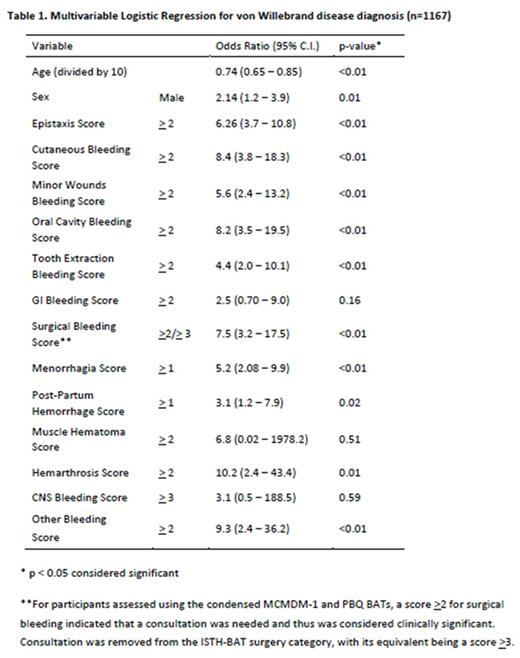Abstract
Introduction: Over the past decade there has been significant focus on the development of bleeding assessment tools (BATs) to address the challenge of quantifying bleeding symptoms and aid in diagnosis of bleeding disorders such as von Willebrand disease (VWD). Abnormal bleeding scores derived from BATs have been shown to discriminate between healthy subjects and those with VWD in both pediatric and adult populations.BATs used to quantify bleeding symptoms have been in circulation for the past decade and significant data have been collected from their use. The objective of our study was to use our legacy data to determine which questions from BATs are the strongest predictors of VWD diagnosis.
Methods: Bleeding score data collected previously by our research team using three BATs (Pediatric Bleeding Questionnaire (PBQ), condensed MCMDM-1, ISTH-BAT) were collated and used for the analysis. Questions on the BATs relate to different bleeding symptoms and each symptom is scored based on its severity. Scores for each bleeding symptom were first sorted based on whether they indicated clinically significant bleeding (i.e., when medical attention was sought or bleeding was spontaneous) which varied with the symptom and BAT administered. Scores considered non-significant/trivial were set as the reference category. Multivariable logistic regression was then used to determine the symptoms that were the strongest predictors of VWD diagnosis (determined by laboratory data). Given that many of the bleeding symptoms are age- and sex-specific, these variables were included in the model.
Results: 1167 participants were included in the analysis; 178 (15%) were VWD patients and 989 (85%) were healthy controls. Of the VWD patients, 60% had Type 1 VWD. The median age was 30 years (range: 5 months - 90 years) and approximately two-thirds of the participants were women (732/1167). The top three symptoms for which having clinically significant bleeding scores increased the odds of having VWD were Hemarthrosis (OR 10.2, 95% CI, 2.4-43.4), Other Bleeding [includes: hemorrhage at miscarriage, hematuria, subconjunctival bleeding, umbilical stump bleeding, cephalohematoma, cheek hematoma during breast/bottle feeding, post-circumcision, post-venipuncture bleeding and bleeding unspecified (OR 9.3, 95% CI 2.4-36.2)] and Cutaneous Bleeding (OR 8.4, 95% CI, 3.8-18.3). Muscle Hematoma, Gastrointestinal (GI) Bleeding and Central Nervous System (CNS) Bleeding were the only symptoms found not to significantly increase odds of VWD diagnosis.
Conclusion: Our results showed that most of the symptoms assessed by existing BATs are significant predictors of VWD diagnosis, which suggests that a comprehensive bleeding history is necessary for understanding a patient's phenotype. However, we did find variability in the weighting of each symptom in relation to predicting VWD. This finding may inform the development of future BATs where a relative weighting could be given to each symptom. We also found that the symptoms of CNS bleeding, muscle hematoma, and GI bleeding did not significantly increase odds of VWD diagnosis. It is possible that future BATs could be streamlined by omitting questions related to these symptoms. Prospective validation of such a tool could be undertaken in further research.
James: Shire: Research Funding; Bayer: Research Funding; CSL Behring: Research Funding.
Author notes
Asterisk with author names denotes non-ASH members.


This feature is available to Subscribers Only
Sign In or Create an Account Close Modal